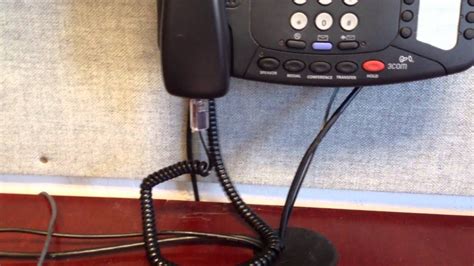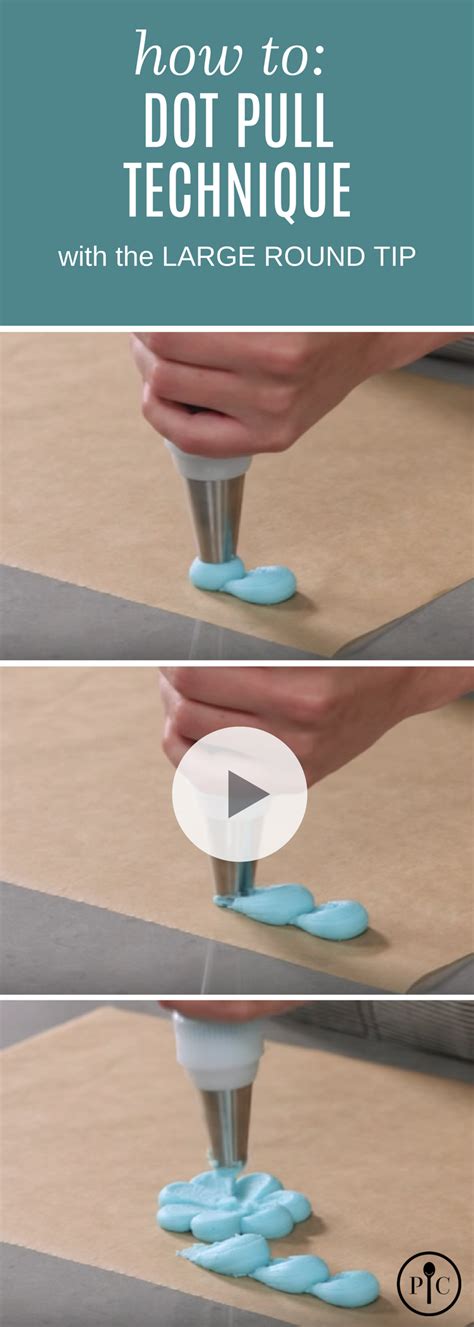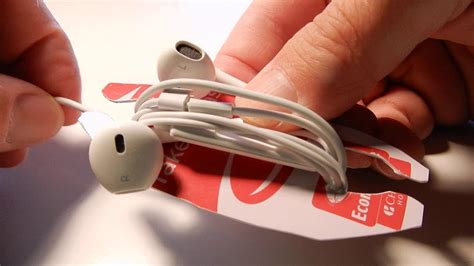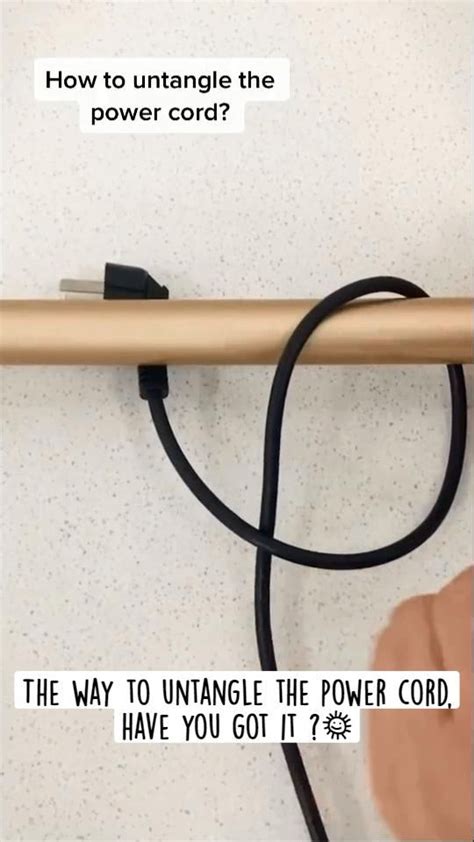Life has an uncanny way of tangling things up. So do the intricate web of wires that comprises our beloved audio devices. Whether it's the earphones we can't live without or the headphones that transport us into a world of musical magic, these cords have a tendency to become snarled messes that test even the most patient of souls. But fear not, for in the realm of wiry chaos, there exists a realm of expertise that can untangle the most intricate of knots.
Picture this – a world where the dreaded battle with rebellious headphone cords is a mere memory. Imagine effortlessly partaking in your favorite tunes without the maddening interruption of incessantly locked wires. As if an invisible hand were guiding your fingertips, coaxing even the most stubborn of knots into submission. In this realm, you become the master of your audio-related predicaments, armed with a collection of simple yet ingenious tricks that will banish tangled cords to the realm of long-forgotten nuisances.
Prepare to embark on a journey of discovery, a quest for knowledge that will equip you with the tools necessary to conquer the chaos that ensues when wires and knots collide. From techniques handed down through generations to innovative hacks of the digital age, you will explore a plethora of solutions that will transform your auditory experience from a frustrating battlefield to a harmonious haven. Strong and determined, you will unravel the mysteries of the tangled web and emerge victoriously, with neatly coiled cords that will leave you wondering why such a seemingly trivial task had once seemed insurmountable.
Start with a Detangled Cord

When it comes to managing your audio experience, a crucial first step is ensuring that your headphone cords are free of tangles. Tangled cords can lead to frustrating moments of trying to unravel knots before you can even enjoy your favorite tunes. In this section, we will explore effective techniques and strategies to start with a detangled cord, allowing for a hassle-free listening experience.
One method to begin with is the twist and wrap technique. By carefully twisting the length of the cord in one direction and then wrapping it around your hand or a cord management device, you can prevent tangling and create a more organized setup. Alternatively, you can try the figure-eight method, where you create a series of loops resembling the number eight with your cord, ensuring that it doesn't overlap or twist upon itself.
Another approach worth considering is using cord management accessories. These may include cord clips, cable organizers, or even Velcro straps. Cord clips can be easily attached to clothing or surface edges, keeping the cable neat and tangle-free. Cable organizers provide designated compartments to hold headphone cords safely, preventing entanglement. Velcro straps can secure your cord, allowing for easy storage and preventing knots from forming.
Furthermore, investing in tangle-free headphones or cords with built-in retractable mechanisms can go a long way in preventing tangles altogether. These innovative designs eliminate the need for manual detangling and provide a convenient solution for those tired of battling with knots.
| Benefits of a Detangled Cord |
|---|
|
In conclusion, starting with a detangled cord is an essential step in maintaining a hassle-free headphone experience. By implementing various techniques such as the twist and wrap method, utilizing cord management accessories, or considering tangle-free designs, you can save time, reduce frustration, and prolong the lifespan of your headphones. Remember, a detangled cord not only improves functionality but also adds to the overall aesthetics of your audio setup.
Master the "Figure Eight" Technique
Discover a game-changing method for managing tangled cords with the innovative "Figure Eight" technique. This simple yet effective approach allows you to effortlessly organize and store your cords, keeping them tangle-free and readily accessible.
- Create a loop with the cord and hold it towards the middle, forming a "U" shape.
- Next, take the cord's loose end and bring it over the middle section, forming a loop.
- Pass the loose end through the loop you've just created, making sure it is pulled tight.
- Repeat this process with the other loose end, forming another loop on the opposite side of the "U" shape.
- Again, pass the loose end through the loop, ensuring it is snugly secured.
- Continue alternating between the two loose ends, forming additional loops and passing them through.
- Once you reach the ends of the cord, secure the last loop by tucking it underneath the final loop or using a small rubber band.
This technique not only prevents your headphone cords from tangling but also makes it easier to unravel and use them whenever needed. By mastering the "Figure Eight" technique, you can say goodbye to frustrating cord entanglements and enjoy hassle-free listening experiences.
Master the "Loop and Pull" Technique

Discover an effective method for effortlessly unraveling entangled headphone cords with the ingenious "Loop and Pull" technique. By applying this simple yet practical technique, you can quickly and efficiently untangle your headphones without the need for any specialized tools or complicated maneuvers.
Start by taking hold of the tangled mess of cords and identifying the points where they intersect. Begin by creating a loop with one section of the cord, pulling it through the intersecting point. Repeat this process for each intersection until the entire length of the cord is looped.
Once you have created multiple loops in the cord, gently pull the loops one by one, guiding the cord through the knots. This method allows you to gradually straighten the cord while preventing further tangling. With each loop you pull, you will notice the knots loosening, and eventually, the headphones will be free from entanglement.
The "Loop and Pull" technique is not only efficient in unraveling headphone cords; it can also be applied to various other types of cables such as charger cords and earphone cables. By mastering this technique, you can say goodbye to the frustration of tangled cords and enjoy hassle-free listening experiences.
Please note: It is important to be gentle when using the "Loop and Pull" method to avoid damaging the cords. Take your time and exercise patience to ensure the longevity of your headphone cords.
Unlock the secret to hassle-free cord management with the simple yet effective "Loop and Pull" technique and never struggle with tangled headphones again!
Securely Organize Your Headphone Cords with Velcro Straps
When it comes to keeping your headphone cords tangle-free, one easy and efficient solution is using Velcro straps. These versatile and reusable ties offer a practical way to wrap your cords securely, ensuring easy access and preventing them from getting tangled or damaged. With Velcro straps, you can bid farewell to frustrating knots and messy cords, and enjoy hassle-free listening experiences.
Velcro straps provide a simple and effective way to keep your headphone cords neat and organized. These straps are made with hook-and-loop fasteners, allowing you to easily secure and adjust them according to your cord's length. By bundling your cords together with Velcro straps, you not only eliminate clutter but also protect the cords from being tangled or snagged on other objects.
One of the key benefits of using Velcro straps is their reusability. Unlike other cord management solutions that require you to constantly purchase new accessories, Velcro straps can be used repeatedly, making them a cost-effective option. Whether you want to store your headphones in your bag, hang them on a hook, or simply keep them organized on your desk, Velcro straps provide a reliable and durable solution for keeping your cords secure.
Another advantage of using Velcro straps is their versatility. These straps come in various sizes and colors, allowing you to customize your cord organization to suit your preferences. You can choose thin straps for earbud cords or opt for wider ones for bulkier headphone cables. Moreover, the different colors available enable you to color-code your cords, making it quick and easy to identify them at a glance.
In conclusion, when it comes to managing and organizing your headphone cords, Velcro straps offer a convenient and practical solution. With their ease of use, reusability, and versatility, you can say goodbye to the frustrations of tangled cords and effortlessly enjoy your music or podcasts with ease.
Proper Storage Techniques to Prevent Tangled Headphone Wires

Ensuring a hassle-free audio experience starts with proper storage of your beloved headphones. By implementing a few key techniques, you can prevent those frustrating tangles that often occur. Here are some practical tips for storing your headphones effectively:
- Invest in a headphone case or pouch: The first step to preventing tangled cords is to provide a protective and organized storage solution. Consider purchasing a dedicated case or pouch designed specifically for headphones. These storage options typically have compartments and cable management systems that keep your cords neat and untangled.
- Wrap the cords correctly: Properly coiling your headphone cords is an essential skill to prevent tangles. Start by holding the plug end and unravel any knots or twists carefully. Then, using your hand or a cord wrap, begin to coil the wire in a loose manner. Avoid tightening the loops too much as this can lead to unnecessary tangling.
- Utilize cord management accessories: Various cord management accessories are available to help keep your headphone cords organized. Cable clips, Velcro straps, and twist ties are just a few examples of tools that can be used to secure your cords neatly. Experiment with different options to find the solution that works best for you.
- Avoid storing headphones with other objects: It's important to keep your headphones separate from other items, especially those with potential for tangling. Store your headphones in a dedicated spot, away from keys, coins, or other objects that could entangle the cords.
- Hang or hook your headphones: If you prefer a more visible storage solution, consider hanging your headphones on a hook or rack. This method conveniently keeps the cords suspended and prevents them from becoming tangled with other items. Additionally, it helps to keep the cords off the floor or desk, further reducing the risk of tangles.
By implementing these proper storage techniques, you can minimize the chances of dealing with tangled headphone cords. Taking a few extra moments to store your headphones correctly will save you time and frustration in the long run, ensuring a pleasant listening experience every time you reach for your favorite pair of headphones.
Consider Utilizing Cable Organizers
In order to effectively manage and optimize the organization of your headphone cords, it is worth considering the utilization of cable organizers. These handy accessories are designed to provide a streamlined solution for keeping your cords untangled and easily accessible.
By utilizing cable organizers, you can minimize the frustration of dealing with tangled cords, allowing you to enjoy your music or audio without any distractions. These organizers come in various shapes and sizes, offering you a range of options to suit your specific needs and preferences.
One popular type of cable organizer is the cable clip. This small yet practical accessory allows you to securely fasten your headphone cord to your clothing or bag, preventing it from tangling or getting caught on objects. Cable clips are lightweight and easy to use, making them a convenient choice for on-the-go individuals.
Another helpful cable organizing solution is the cable wrap. These wraps are designed to neatly bundle your headphone cords, keeping them tidy and easily storable when not in use. Cable wraps are often adjustable, allowing you to customize the length and tightness of the wrap to suit your preferences.
If you prefer a more versatile option, consider using cable sleeves. These sleeves are designed to encase and protect your headphone cords while providing a clean and organized appearance. Cable sleeves are available in different materials, such as fabric or neoprene, giving you the freedom to choose the one that suits your style and needs.
When purchasing cable organizers, ensure that they are compatible with your headphone cord's length and thickness. Additionally, consider the durability and quality of the organizers to ensure they will effectively withstand regular use without wearing out or deteriorating.
By incorporating cable organizers into your headphone cord management system, you can conveniently keep your cords untangled, reduce clutter, and enhance your overall listening experience.
Untangling Cords with a Needle or Pin

Efficiently managing tangled cords can be a frustrating task, but with the help of a simple needle or pin, you can quickly untangle them and restore order to your headphones or other electronic devices. This technique utilizes the sharp point of a needle or pin to delicately separate the intertwined cords, allowing them to easily untwist and regain their intended form.
Step 1: Begin by identifying the starting point of the tangle. Gently hold the cord near this point to prevent it from becoming further entangled.
Step 2: Take the needle or pin and carefully insert its sharp end into the tangled area. Be cautious not to apply excessive force, as this could damage the cord.
Step 3: Once the needle or pin is inserted, gently move it back and forth to loosen the tangle. This motion will help separate the individual cords and create space for them to unwind.
Step 4: As you loosen the tangle, you may find it helpful to use your fingers to hold the separated cords apart, preventing them from re-tangling as you work your way through the knot.
Step 5: Continue inserting the needle or pin, and repeating the back-and-forth motion until the entire tangle is resolved. Take your time and be patient, as rushing the process may result in further entanglement.
Step 6: Once the cords are mostly untangled, gently pull them apart to remove any remaining twists or knots. If necessary, repeat the previous steps to address any stubborn tangles.
Note: It is important to exercise caution while using a needle or pin to untangle cords, as they can cause injury if mishandled. Ensure you are working in a well-lit area and take breaks if you start to feel fatigued or frustrated.
By following these steps, you can effectively untangle cords using a needle or pin, saving you time and frustration when dealing with tangled headphone cords or any other cable mess. This simple yet effective technique is a valuable skill to have in your cord management toolkit!
Avoid Tangles by Keeping Cords Separate
Tangled cords can be frustrating and time-consuming to untangle. To prevent knots and keep your headphone cords organized, it is important to keep them separate and untangled. By following a few simple tips and using practical tricks, you can ensure that your cords remain free of tangles and knots.
- Use Cord Organizers: Invest in cord organizers such as cable clips, cable sleeves, or cable ties. These handy tools can help you keep your cords separate and prevent them from tangling together.
- Wrap Cords Individually: When storing your headphones, make sure to wrap each cord separately. Start by making a loose loop at one end and continue wrapping the cord around it. This technique not only prevents tangles but also makes it easier to unravel the cord when you need to use it.
- Label Your Cords: Another effective way to keep cords separate is by labeling them. You can use colored tape, stickers, or labels to identify each cord. This simple step will save you time and effort when searching for a specific cord.
- Shorten Excess Cord Length: Long cords have a higher chance of getting tangled. If your headphone cords are too long for your needs, consider shortening them. You can use cable organizers or simply tie up the extra length with a twist tie or Velcro strap.
- Store Cords Properly: When not in use, be sure to store your headphone cords in a neat and organized manner. You can use a small pouch, cord organizer case, or even a simple drawer to keep them separate and prevent them from getting tangled with other items.
By implementing these techniques and staying consistent with your cord management, you can easily avoid knots and tangles in your headphone cords. Keeping your cords separate not only saves you time but also extends the lifespan of your headphones by reducing wear and tear caused by frequent untangling. So take a few extra seconds to keep your cords organized, and say goodbye to frustrating tangles!
Try Wireless Headphones as an Alternative

In this section, we will explore the advantages of utilizing wireless headphones as a viable option to overcome the challenges and inconveniences associated with tangled cords. By considering wireless headphones, you can enjoy a hassle-free audio experience without the need to deal with the frustration of untangling cords.
Embrace Convenience: Wireless headphones offer the freedom and convenience of untethered listening. With no cords to worry about, you can move more freely and engage in activities without being restricted by cable length.
Enhanced Mobility: With wireless headphones, you can effortlessly navigate through your daily routine without the fear of cords getting entangled in objects or getting in your way. Whether you are at the gym, commuting, or working, wireless headphones allow you to focus on what matters most.
Improved Aesthetics: Say goodbye to the visual clutter created by tangled headphone cords. Wireless headphones provide a sleek and stylish look, allowing you to maintain a clean and organized appearance while enjoying your favorite music or podcasts.
Seamless Connectivity: Wireless headphone technology has advanced significantly, ensuring smooth and reliable connections. With features like Bluetooth connectivity, quick pairing, and stable signals, you can easily connect your headphones to compatible devices and enjoy uninterrupted audio.
Enhanced Comfort: Wireless headphones often come with ergonomic designs that prioritize comfort during extended use. With no cords to get tangled or caught on objects, you can enjoy a comfortable listening experience without any distractions.
Consider exploring wireless headphones as a practical and convenient alternative to traditional wired headphones. By embracing wireless technology, you can bid farewell to the hassle of untangling cords and embrace a truly wireless audio experience.
[MOVIES] [/MOVIES] [/MOVIES_ENABLED]FAQ
What are some easy tips and tricks for untangling headphone cords?
There are several easy tips and tricks to untangle headphone cords. One trick is to hold the headphone plug and let the cord hang freely, then give it a few shakes to allow the cord to naturally straighten out. Another tip is to use a binder clip or hair clip to secure one end of the cord, then gently pull the other end to straighten it out. Additionally, you can try using a straw or a pen to wrap the cord around to prevent tangling. Finally, storing headphones in a protective case or using a cord organizer can also help prevent tangling.
Is there a specific technique for untangling headphone cords?
While there is no one-size-fits-all technique for untangling headphone cords, there are a few methods that can be helpful. One technique is called the "figure-eight" method, where you loosely hold both ends of the cord and create a figure-eight shape by crossing the cord over itself. This helps to loosen any knots or tangles. Another technique is to use your fingers to gently separate any tangled areas, starting from the headphone plug and working your way up to the earbuds. You can also try using a pair of tweezers or a needle to carefully untangle any stubborn knots. It's important to be patient and avoid forcefully pulling on the cord, as this can cause damage.
Are there any tools or accessories that can help with untangling headphone cords?
Yes, there are several tools and accessories that can assist in untangling headphone cords. Cord organizers, such as cable management sleeves or clips, can keep the cords neatly wrapped and prevent tangling when not in use. Velcro cable ties or zip ties can also be useful for securing and organizing cords. Additionally, there are specialized headphone cord winders available, which allow you to wrap the cord around a compact device to keep it tangle-free. Investing in a protective case specifically designed for headphones can also help prevent tangling when storing them.
How can I prevent my headphone cords from tangling in the first place?
To prevent headphone cords from tangling, there are a few preventive measures you can take. One approach is to use the "over-under" wrapping technique when storing your headphones. This involves alternating the direction in which the cord is wrapped each time it is coiled, which helps to prevent tangles from forming. Another method is to secure the cords using a twist tie, rubber band, or Velcro strap when not in use. This keeps the cords organized and reduces the chance of tangling. Additionally, storing headphones in a dedicated case or pouch can protect them from getting tangled with other items in your bag or pocket.
Can tangled headphone cords cause any damage to the headphones?
Tangled headphone cords can potentially cause damage over time if they are not untangled properly. Twisting and pulling on the cord forcefully can lead to wire fraying or loosening of internal connections, which can affect the audio quality or even render the headphones unusable. Additionally, if the cord is repeatedly bent or twisted in the same spot, it may weaken the wire and eventually result in a break. Therefore, it is important to take care when untangling cords and avoid any excessive force or sharp bends.
What are some easy tips for untangling headphone cords?
There are several easy tips for untangling headphone cords. Firstly, try straightening out the entire length of the cord to identify any knots or tangles. Then, gently pull each end of the cord in opposite directions to loosen the tangles. If the cords are still tangled, you can use a small amount of baby powder or talcum powder on your fingers to reduce friction and make it easier to untangle the knots. Another useful tip is to store your headphones properly by using a cord wrap or a cord organizer to prevent tangling in the first place.
Are there any specific techniques for untangling headphone cords?
Yes, there are specific techniques that can help untangle headphone cords effectively. One technique is the "finger and thumb" method, where you grip the cord with your fingers and thumb, then run them down the cord to straighten out any tangles. Another technique is the "rolling" method, where you roll the cord between your hands, applying gentle pressure to smoothen out the tangles. Additionally, you can try the "looping" technique, where you create small loops along the cord and gently pull them apart to remove any knots. Remember to be patient and avoid yanking on the cord, as it may damage the wires inside.




